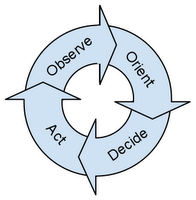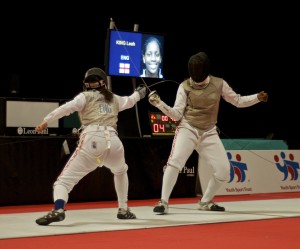THERE’S a cannon that’s already lobbed a couple of shells at you, creating geysers more nearby than you’d like.
The gunner behind that cannon is your mortal adversary. He knows that if you can get in close enough, your torpedoes will blow his ship to Kingdom Come – and him with it. His advantage is long-range cannon power, and the stable platform of a battle cruiser to shoot from. Yours is that you’re driving the fastest, most maneuverable naval boat afloat.
Your engines are red-lining and howling. You’re racing at his ship in your Patrol Torpedo (PT) Boat at maximum speed in hopes of getting within range to release your torpedoes before he can blow you out of the water.
He started by firing in front of you to disrupt your path and visibility, and his shots are now marching toward you. They’re also alternating between being to your left and to your right, and getting ever closer each time.
The enemy gunner is using a feedback loop to bring his fire on top of you. When he sees from the splash that the shell landed to the right of your path, he corrects somewhat to the left. When the next shell he fires lands to your left, he corrects to the right, each time closer to his intended target: you.
Recognizing his pattern, you do what a smart PT Boat Captain should do. Without slowing, you radically steer toward the last splash. Given the way the feedback loop in the gunner’s head works, you know that the last splash is the one place the next shell won’t land.
Here’s the next splash. It’s further away, and you re-aim your boat toward that. Your now-drenched crew is hanging on for dear life. Wildly chasing the splashes diverts you from your path somewhat, but your net speed and direction is still toward the cruiser and you’re getting closer.
It’s working. You get to your release point, fire your torpedoes, reverse your course, still jukeing toward the splashes, and get the hell out of there.
Your torpedoes are heading in the general direction of the cruiser that’s now straining to lumber out of their way.
The gunner was using a well-tuned feedback loop to bring his shots closer and closer to you, until he scored a hit. But you understood the logic of his loop, took advantage of it, and defeated it.
[And what happened to the battle cruiser? You damaged its rudder. It’s going in circles, awaiting its fate.]
In the last post the point was made that feedback loops are all around us. That suggests that if we’re in some sort of adversarial situation, it’s definitely worth looking for a feedback loop to disrupt. For instance …
A few examples
Sports – We can see feedback loops at work in most sports. Sometimes we need to stimulate them in our opponents, so that we can then take advantage of them.
If a tennis player can alternately make a series of shots to opposite sides of the court, he can cause his opponent to fall into a loop of running back and forth and back and forth to return the shots. Once the loop is established, making a shot near the same place as the last one, just as the opponent has started to move in the other direction, will disrupt his loop and he’ll be unable to get to the ball. In Grand Slam broadcasts, it’s fun to watch the players duel to establish and take advantage of feedback loops in their opponents play.
Sometimes the loops are short-lived. When attacking, a fencer can use a strong feint to induce the opponent to try to parry (block) a thrust to an open target, initiating a loop in the opponent’s behavior. The attacker can then instantly evade the parry, threatening a different target. This causes the opponent to try to parry that threat, which the attacker can evade, and then drive home the attack before the defender can adequately respond. In the photo, the attacker has gotten ahead of the defender’s loop. Touche.
Establishing and taking advantage of an opponent’s loop has been going on in fencing for literally millennia. In today’s fencing, this action can take place in less than a second, start to finish. A momentary loop, but long enough to do the job.
Business – In manufacturing industries, it’s usually not hard to find feedback loops at work in a competitor’s business processes. Look at new product introductions in the PC industry. There have been traditionally two factors controlling them: 1) availability of the next generation of processor chip technology, and 2) consumer buying behavior seasonality (esp. back-to-school and the holiday season).
Chip supplier Intel has largely controlled factor 1), leaving little to play with there. But investing in a focused Research & Development effort to beat other competitors to market (by sufficient time, but not too much: seasonality) with the latest & greatest technology and features can sometimes get you inside your competitors’ product intro loop and provide you with the higher profits that go with first-to-market products.
The higher returns can be re-invested in advanced R&D for the next cycle, and you’re now inside your competitors’ loops and on the right side of the investment /return curve.
Animal Behavior – Ever see a video of a mongoose taking on a cobra? Check this out. Using feints, the mongoose induces the cobra to fall into a behavioral loop, fatiguing it. The mongoose then rushes in, getting inside the snake’s loop, and nails it.
As can be seen in these examples, the fact that the party that’s disrupting the feedback loop of an opponent takes the initiative, allows the disruptor to get ahead of the disruptee and defeat his loop. This is called “getting inside the loop” of his opponent. The Captain of the PT Boat got inside the loop of the cruiser gunner and defeated it. Similarly with the tennis player, the fencer, the business strategist and the mongoose. In all these cases, the basic strategy is the same: induce or find a loop and disrupt it. This is generally much more efficient than brute force strategies. For at least a moment, it creates an opportunity: a mismatch between your advantage and your opponent’s vulnerability. And that sheds a lot of light on how to win.
Let’s take a broader look at getting inside feedback loops.
The OODA Loop
 Getting inside the loop of an adversary was put to good use
Getting inside the loop of an adversary was put to good use and formalized as a principle by fighter pilot John Boyd. Boyd recognized that the principle had application to all levels of warfare and worked hard to promulgate it. The idea has found its way into much current military doctrine.
and formalized as a principle by fighter pilot John Boyd. Boyd recognized that the principle had application to all levels of warfare and worked hard to promulgate it. The idea has found its way into much current military doctrine.
He modeled it as the OODA Loop (Observe, Orient, Decide, Act). In a dogfight, both fighter pilots are basing what they do on their own OODA Loops. Pilot A commits an act that is Observed by Pilot B, who then Orients himself to the new situation, Decides what to do and then Acts accordingly. Pilot A then Observes B’s act, Orients himself to it, Decides what he’ll do, and then Acts, etc. etc., until one of the pilots gains the initiative and acts again, before the other pilot can finish his loop. This blows away the other pilot’s loop, and he becomes fair game.
Again, from an adversarial strategy point of view, the key is to find a loop that can be stimulated, stimulate it, and then undermine it. You hack their feedback loop.
Then what happens?
It doesn’t end there. A good adversary will both try to prevent you from messing with his loops and try to mess with yours. If the cruiser gunner in our first example had recognized what was going on, he could have just aimed at his own last splash and hit the PT Boat. The defending fencer could have disrupted the attacking fencer’s loop by thrusting into the attack or feinting a parry and then executing a real one.
This is when it all becomes very interesting: when both adversaries are actively engaged in undermining the other’s feedback loops …
________________________________________________________________
Readers are encouraged to add comments to this post.
And if you’d like to share or recommend the post, click on your preferred way in the left margin sidebar.
In the next post, the topic will be Distributed Strategies; the Personal Dikes of Hamburg.
If you’re not currently being automatically notified when new posts are published, then please Follow Real Strategy (top of right hand column on this page), and indicate how you’d prefer to be notified.
For other posts of interest, click on the Smart Menu tab.
Photo credit: PT Boat, JalopyJournal.com
Photo credit: Caught Out of Loop, AFP (Agence France-Presse), 2012
Photo credit: Getting Ahead of the Opponent’s Loop, WhoTalking.com
Video credit: Mongoose vs. Cobra, National Geographic
Photo credit: OODA Loop Graphic, C2 ways
Photo credit: Dogfight, the full wiki









Like to hear more about fencing….
[Translate]
This is one of your neater ideas and sets of examples, and i’m trying to apply it to, of all things, to maneuvers in music – jazz and gypsy music specifically, although the idea is clear in the surprises in things like a Bach fugue
[Translate]
Very intresting, Rus. You inspire me to pay more attention to the structure and patterns of the music I listen to. Your application of the strategy reinforces an important point of the Real Strategy blog: strategies are strategies, independent of the field of use, and that an example of a given strategy in one field can lead to surprising uses of the same strategy in other fields. Thanks for the comment.
[Translate]